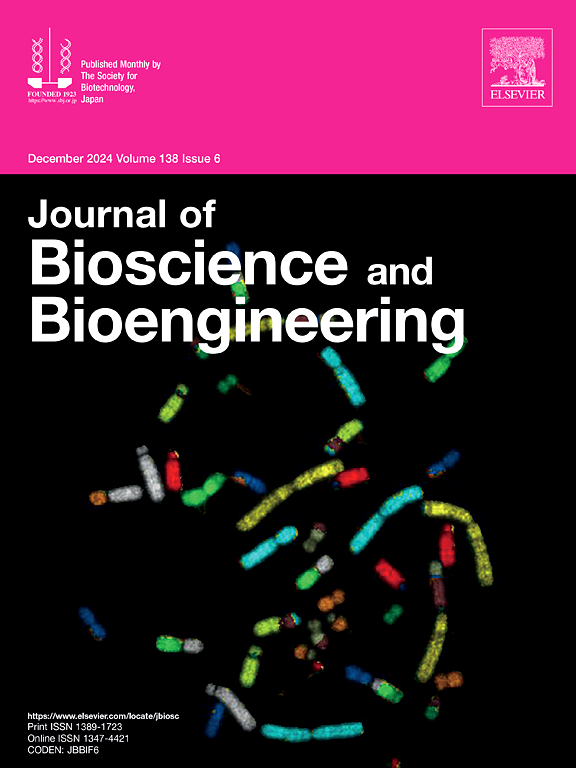在96孔级微设备上构建可收缩的人类ipsc衍生骨骼肌组织。
IF 2.9
4区 生物学
Q3 BIOTECHNOLOGY & APPLIED MICROBIOLOGY
引用次数: 0
摘要
组织工程三维(3D)骨骼肌可以潜在地用于基于收缩力的表型筛选,以阐明骨骼肌功能障碍的机制,并制定预防和治疗策略。表达四环素诱导的肌源分化1 (MYOD1)的人诱导多能干细胞(hiPSCs)是构建组织工程骨骼肌的一种有前途的细胞来源。虽然我们在之前的研究中成功地使用这些hiPSCs构建了可收缩组织,但由于它们的收缩力弱,筛选能力低,需要进一步改进。在这项研究中,我们的目标是使用我们之前开发的96孔规模的微型设备构建具有高收缩力的ipsc衍生肌肉组织。为了提高收缩力,我们优化了转化生长因子-β (TGF-β)抑制剂SB431542 (SB)的添加时间,以确定增强收缩力的培养条件。添加SB的最大收缩力(58.45±20.14 μN)约为未添加SB的5倍(11.64±4.86 μN)。包括免疫染色、透射电镜、基因表达分析和蛋白质组学在内的各种分析显示,在SB的存在下,肌管分化和肌肉组织成熟增强。使用抑制剂的实验表明,TGFβ1,而不是肌肉生长抑制素,部分参与了这些作用。此外,我们证实了杜氏肌营养不良症患者的ipsc构建的组织在添加SB后也显示出改善的收缩性。因此,在96孔微设备上用SB培养的ipsc来源的肌肉组织为筛选可以改善疾病病理的化合物提供了一个有希望的平台。本文章由计算机程序翻译,如有差异,请以英文原文为准。
Construction of contractile human iPSC-derived skeletal muscle tissues on 96-well scale microdevices
Tissue-engineered three-dimensional (3D) skeletal muscles can be potentially used in contractile force-based phenotypic screening to elucidate the mechanisms of skeletal muscle dysfunction and develop preventive and therapeutic strategies. Human induced pluripotent stem cells (hiPSCs) expressing tetracycline-inducible myogenic differentiation 1 (MYOD1) are a promising cell source for construction of tissue-engineered skeletal muscles. Although we successfully constructed contractile tissues using these hiPSCs in a previous study, further improvements are required because of their weak contractile force and inefficient screening capabilities. In this study, we aimed to construct iPSC-derived muscle tissues with high contractile force using a 96-well scale microdevice that we had previously developed. To increase the contractile force, we optimized the time of supplementation of the transforming growth factor-β (TGF-β) inhibitor, SB431542 (SB), to identify culture conditions that enhance contractile force. The maximum contractile force with addition of SB was approximately five times greater than that without SB (58.45 ± 20.14 μN with SB compared to 11.64 ± 4.86 μN without SB). Various analyses, including immunostaining, transmission electron microscopy, gene expression analysis, and proteomics, revealed enhanced myotube differentiation and muscle tissue maturation in the presence of SB. Experiments using inhibitors indicated that TGFβ1, not myostatin, is partially involved in these effects. Furthermore, we confirmed that tissues constructed from iPSCs derived from patients with Duchenne muscular dystrophy also showed improved contractility following addition of SB. Therefore, iPSC-derived muscle tissues cultured with SB on the 96-well microdevice provide a promising platform for screening compounds that can ameliorate disease pathology.
求助全文
通过发布文献求助,成功后即可免费获取论文全文。
去求助
来源期刊

Journal of bioscience and bioengineering
生物-生物工程与应用微生物
CiteScore
5.90
自引率
3.60%
发文量
144
审稿时长
51 days
期刊介绍:
The Journal of Bioscience and Bioengineering is a research journal publishing original full-length research papers, reviews, and Letters to the Editor. The Journal is devoted to the advancement and dissemination of knowledge concerning fermentation technology, biochemical engineering, food technology and microbiology.
 求助内容:
求助内容: 应助结果提醒方式:
应助结果提醒方式:


